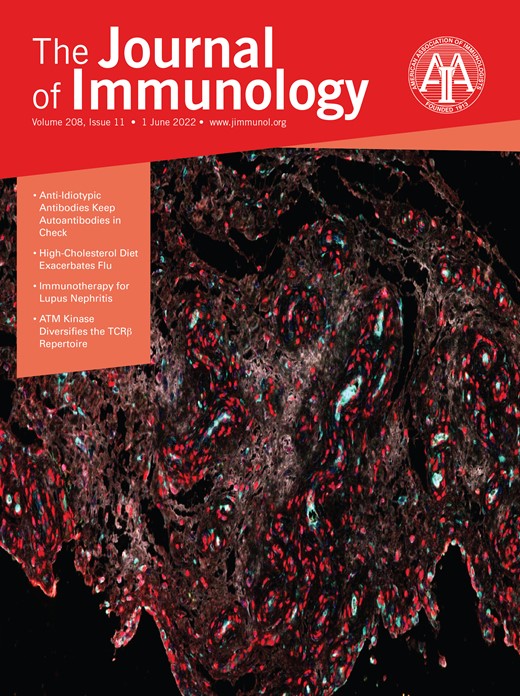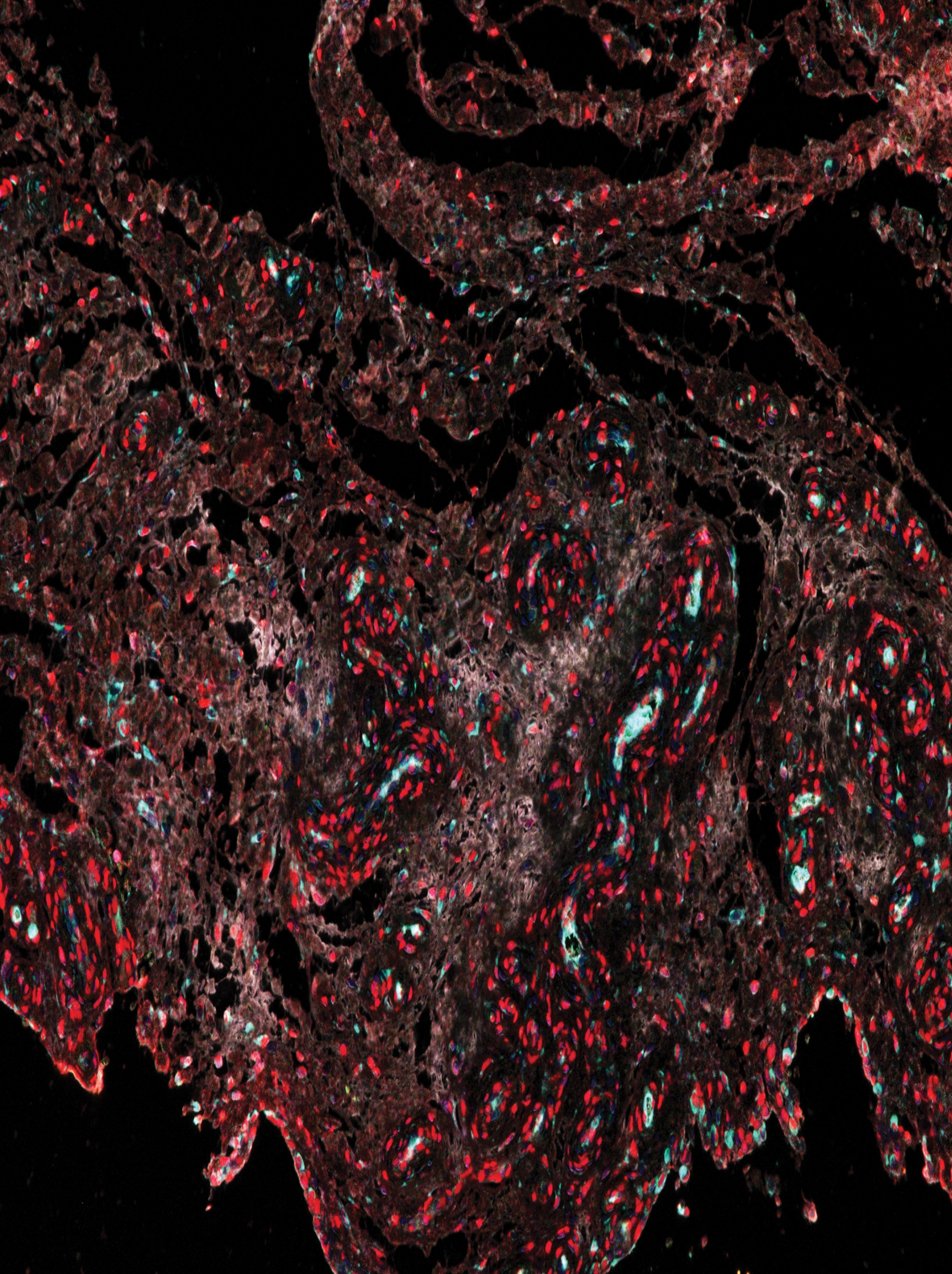
Cover image

On the cover: A composite image showing multiplexed immunohistochemical staining of seven complement proteins simultaneously from the knee joint synovial biopsy of an early rheumatoid arthritis patient. Color coding key is as follows: C3c, red; CFB, pink; CFH, cyan; CFHR4, magenta; MBL2, green; FCN3, white; C5b-9 (MAC), yellow. Banda, N. K., K. D. Deane, E. A. Bemis, C. Strickland, J. Seifert, K. Jordan, K. Goldman, Accelerating Medicines Partnership (AMP) RA/SLE Network, B. P. Morgan, L. W. Moreland, M. J. Lewis, C. Pitzalis, and V. M. Holers. 2022. Analysis of complement gene expression, clinical associations, and biodistribution of complement proteins in the synovium of early rheumatoid arthritis patients reveals unique pathophysiologic features. J. Immunol. 208: 2482–2496.
Volume 208, Issue 11, June 2022
President’s Address
The All-Encompassing Importance of Innate Immunity
In their AAI President’s Addresses reproduced in this issue, Jeremy M. Boss, Ph.D. (AAI ’94; AAI President 2019–2020) and Jenny P.-Y. Ting, Ph.D. (AAI ’97; AAI President 2020–2021) welcomed attendees to the AAI annual meeting, Virtual IMMUNOLOGY2021™. Due to the SARS-CoV-2 pandemic and the cancellation of IMMUNOLOGY2020™, Dr. Boss and Dr. Ting each presented their respective President’s Address to open the meeting.
The Regulation of Immunity
In their AAI President’s Addresses reproduced in this issue, Jeremy M. Boss, Ph.D. (AAI ’94; AAI president 2019–2020), and Jenny P.-Y. Ting, Ph.D. (AAI ’97; AAI president 2020–2021), welcomed attendees to the AAI annual meeting, Virtual IMMUNOLOGY2021™. Due to the SARS-CoV-2 pandemic and the cancellation of IMMUNOLOGY2020™, Dr. Boss and Dr. Ting each presented their respective president’s address to open the meeting.
Top Reads
Top Reads
Pillars of Immunology
CCR5: The Receptor That Unlocks the Door for HIV Entry into Cells
This Pillars of Immunology article is a commentary on “Identification of a major co-receptor for primary isolates of HIV-1,” a pivotal article written by H. Deng, R. Liu, W. Ellmeier, S. Choe, D. Unutmaz, M. Burkhart, P. Di Marzio, S. Marmon, R. E. Sutton, C. M. Hill, et al., and published in Nature, in 1996. https://www.nature.com/articles/381661a0.
Cutting Edge
Cutting Edge: T Cell Responses to B.1.1.529 (Omicron) SARS-CoV-2 Variant Induced by COVID-19 Infection and/or mRNA Vaccination Are Largely Preserved
T cell responses against Omicron are well preserved after COVID-19 or mRNA vaccination.
Recipients of two mRNA vaccine doses only have lower T cell responses.
Autoimmunity
Restoration of Follicular T Regulatory/Helper Cell Balance by OX40L–JAG1 Cotreatment Suppresses Lupus Nephritis in NZBWF1/j Mice
TFR/TFH cell ratio is impaired during the onset of lupus nephritis in NZBWF1/j mice.
OX40L–JAG1 cotreatment expands TFR cells and suppresses TFH cells.
Restoration of TFR/TFH balance ameliorates lupus nephritis in NZBWF1/j mice.
Clinical and Human Immunology
Analysis of Complement Gene Expression, Clinical Associations, and Biodistribution of Complement Proteins in the Synovium of Early Rheumatoid Arthritis Patients Reveals Unique Pathophysiologic Features
The complement system plays a pathophysiologic role in the synovium of early RA.
Correlations were found between DAS28 and complement genes in the early RA synovium.
Early RA synovium shows complement activation versus regulatory protein imbalance.
Immune Regulation
Naturally Occurring Anti-Idiotypic Antibodies Portray a Largely Private Repertoire in Immune-Mediated Thrombotic Thrombocytopenic Purpura
Anti-idiotypes to ADAMTS13 autoantibodies are part of the immune response in iTTP.
ITTP patients have shared ADAMTS13 autoantibodies but private anti-idiotypes.
Anti-idiotypes are capable of neutralizing their own and foreign ADAMTS13 autoantibodies.
Immunogenetics
Genome-Wide Mapping of Plasma IgG N-Glycan Quantitative Trait Loci Identifies a Potentially Causal Association between IgG N-Glycans and Rheumatoid Arthritis
We identified potentially causal associations of IgG N-glycans with RA.
Our findings shed light on IgG N-glycosylation involvement in RA.
Infectious Disease and Host Response
Activation of CD4+ T Cell–Derived Cannabinoid Receptor 2 Signaling Exacerbates Sepsis via Inhibiting IL-10
CB2 signaling activation led to elevated mortality in septic mice.
CD4+ cell–derived CB2 was responsible for decreased survival.
CD4+ cell–derived CB2 exacerbated sepsis by inhibiting IL-10 production.
Dietary Cholesterol Causes Inflammatory Imbalance and Exacerbates Morbidity in Mice Infected with Influenza A Virus
Dietary cholesterol increases morbidity during IAV infection in mice.
Dietary cholesterol neither causes immunosuppression nor alters viral load.
Morbidity is correlated with cytokine-producing lymphocytes and granulocytes.
Translationally Controlled Tumor Protein–Mediated Stabilization of Host Antiapoptotic Protein MCL-1 Is Critical for Establishment of Infection by Intramacrophage Parasite Leishmania donovani
Leishmania induces host antiapoptotic proteins MCL-1 and TCTP to inhibit apoptosis.
TCTP–MCL-1 interaction prevents ubiquitination-mediated degradation of labile MCL-1.
TCTP silencing led to reduction of organ parasite burden in visceral leishmaniasis.
Cyclooxygenase-Derived Prostaglandin E2 Drives IL-1–Independent Mycobacterium bovis Bacille Calmette-Guérin–Triggered Skin Dendritic Cell Migration to Draining Lymph Node
BCG-triggered PGE2 release mobilizes skin DCs to the draining lymph node.
Migrating DCs use EP2 and EP4 to relocate to the draining lymph node.
Live BCG bacilli are needed for PGE2-mediated DC migration.
miR-146a Maintains Immune Tolerance of Kupffer Cells and Facilitates Hepatitis B Virus Persistence in Mice
The abundant miR-146a in KCs plays a key role in maintaining immune homeostasis.
miR-146a promotes HBV persistence by inhibiting KCs proinflammatory polarization.
Clonotypic IgH Response against Systemic Viral infection in Pronephros and Spleen of a Teleost Fish
Anti-VHSV Ab response decreases 4 wk after boost of vaccinated individuals.
Similar frequencies of anti-VHSV public clonotypes occur in pronephros and spleen.
Fish spleen and pronephros are different B cell compartments with distinct repertoires.
Molecular and Structural Immunology
Poor-Quality Vβ Recombination Signal Sequences and the DNA Damage Response ATM Kinase Collaborate to Establish TCRβ Gene Repertoire and Allelic Exclusion
ATM prevents aberrant resolution of attempted deletional Vβ rearrangements.
ATM and weak Vβ RSSs facilitate interallelic competition for Vβ recombination.
ATM and poor-quality Vβ RSSs cooperate to help enforce TCRβ allelic exclusion.


